FX Experience Has Gone Read-Only
I've been maintaining FX Experience for a really long time now, and I love hearing from people who enjoy my weekly links roundup. One thing I've noticed recently is that maintaining two sites (FX Experience and JonathanGiles.net) takes more time than ideal, and splits the audience up. Therefore, FX Experience will become read-only for new blog posts, but weekly posts will continue to be published on JonathanGiles.net. If you follow @FXExperience on Twitter, I suggest you also follow @JonathanGiles. This is not the end - just a consolidation of my online presence to make my life a little easier!
tl;dr: Follow me on Twitter and check for the latest news on JonathanGiles.net.
by Jonathan Giles | Dec 21, 2011 | News
It has been a hectic few months for JavaFX releases recently (and before that it was a hectic year of development building up to JavaFX 2.0!). Today we have another announcement, but first, a quick timeline:
- JavaFX 2.0 for Windows, and JavaFX 2.0 developer preview for Mac OS shipped at JavaOne in early October.
- In mid-October we shipped JavaFX 2.0.1 for Windows. This was a security-only release.
- Earlier this month JavaFX 2.0.2 was released, which included a huge number of bug fixes, optimisations, some new API, and an improved redistribution license.
Today we are proud to announce that JavaFX 2.1 early access is available for Windows. It has been available for Mac OS for quite some time from the same page…
The reason why I say we’re proud: we’re hitting all the targets we’re talking about, and the releases just keep getting better and more featured. JavaFX 2.1 is going to be a more substantial release, and I’m so pleased we can get you early versions of it so soon.
Now, a word of warning: don’t use the early access releases in production – it is pre-beta code and will be more buggy than 2.0.2. We’re putting this out for public use so people may test the new features and provide feedback.
As with all other releases I’ve announced:
- Go to the forums to discuss JavaFX questions you have,
- Sign up to the openjfx-dev mailing list if you’re interested in our open source developments,
- File bug reports over at our Jira issue tracker.
Happy testing!
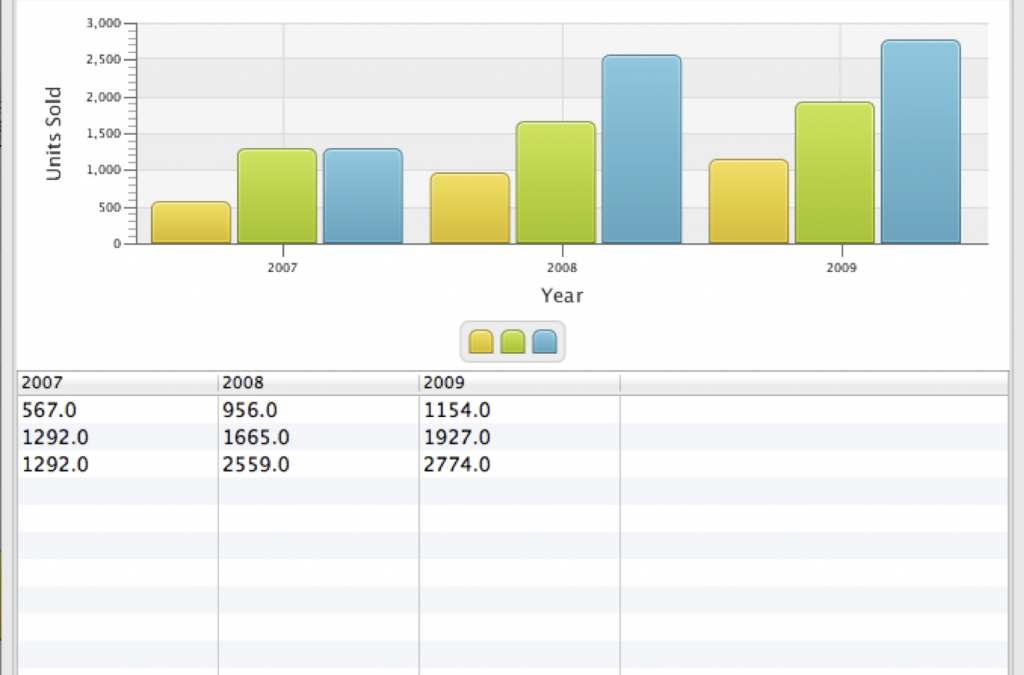
by Richard Bair | Dec 20, 2011 | General, Tips n' Tricks
With JavaFX 2.0.2, we’ve included support for interop with SWT in the same way that we support interop with Swing. That is, you can embed JavaFX within your SWT applications! Although e(fx)clipse has been doing this for a little while by embedding FX -> Swing -> SWT, you can now skip the intermediate embedding into Swing and just go straight to SWT. Because FX and SWT share the same basic threading model, this is really easy to do.
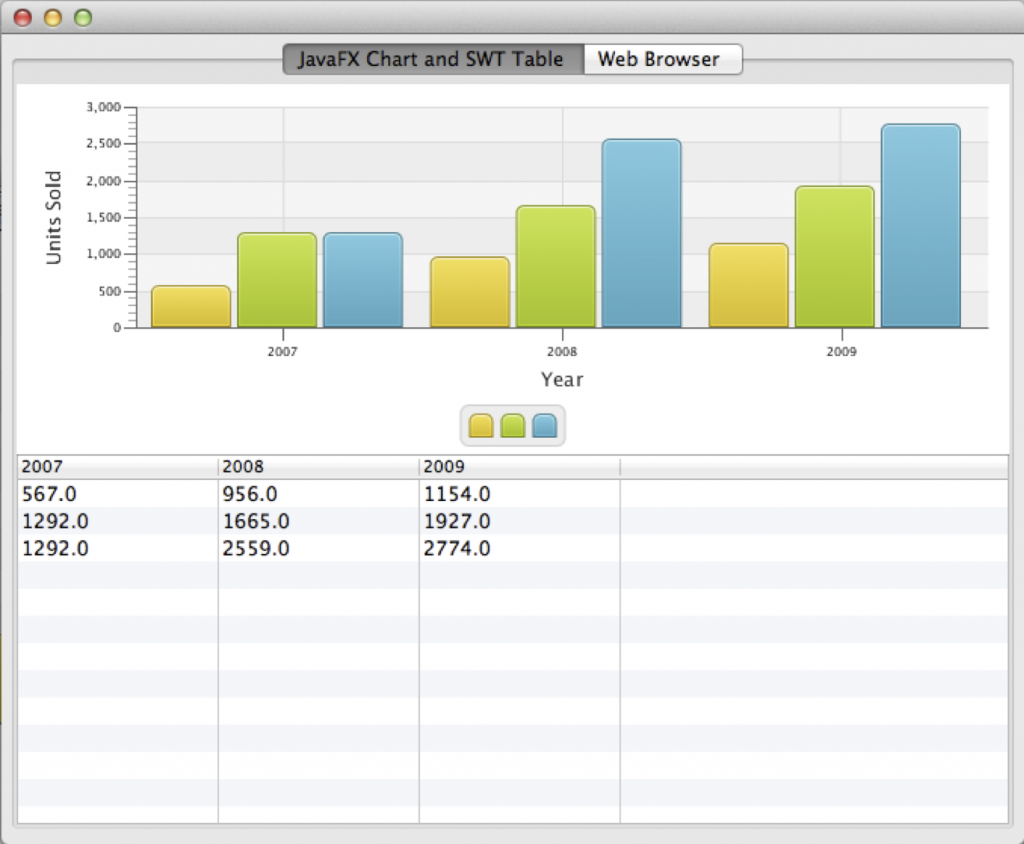
(more…)
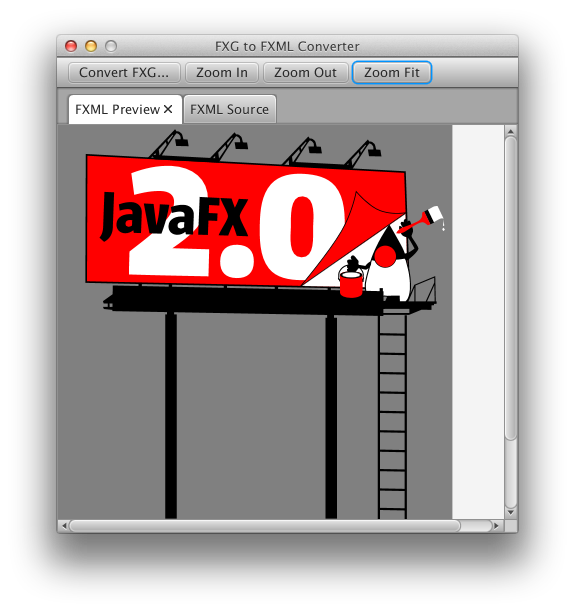
by Jasper Potts | Dec 20, 2011 | FXML
When Eileen and I were working on our session for JavaOne on Designer-Developer workflow we needed a way of converting some vector graphics from Adobe Illustrator into JavaFX. So I tried the FXG to JavaFX converter I found on the web and did not have much luck as what Eileen and draw was pretty advanced. So I thought well FXG is a XML file and FXML is a XML file and as I used to do XML->XML conversion all the time for a previous job using XSLT. I thought how hard can be be to write a converter, well about 4 hours later and some dusting off of The XSLT book here is what I came up with:

(more…)
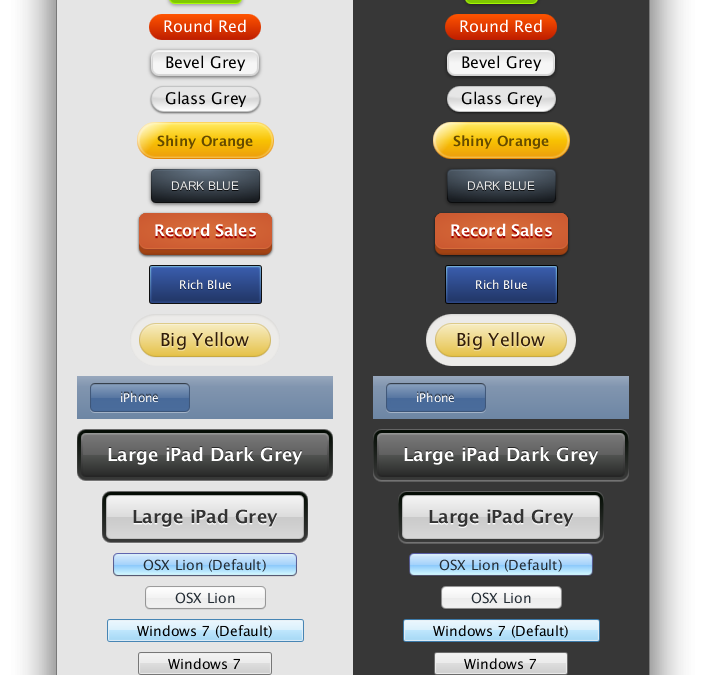
by Jasper Potts | Dec 20, 2011 | Controls, CSS, Tips n' Tricks, UI Design
A number of people have asked me recently can I create this look or that look using CSS in JavaFX. Or they have said that you could never do that! So I thought I would do a little experiment and try recreating a bunch of common button styles purely using CSS. So without further ado, here is the result:
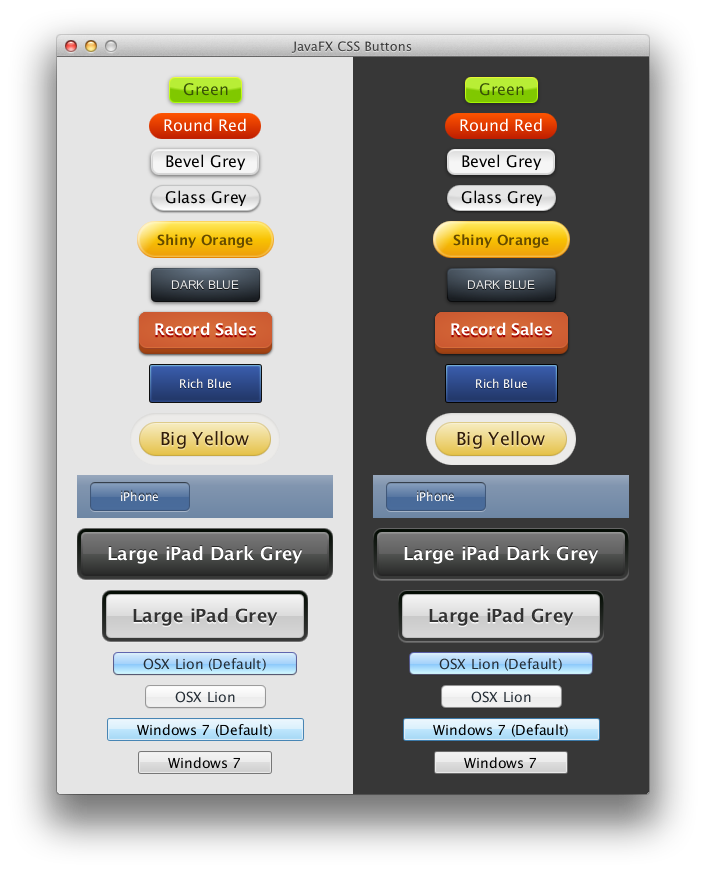
(more…)
by Jonathan Giles | Dec 18, 2011 | Links
Here we go again…..enjoy! 🙂
- JavaFX 2.0.2 was released this week, bringing with it a heap of bug fixes, as well as a number of new features including SWT interoperability, and improved mouse scroll APIs. Additionally, the license was updated to allow for redistribution.
- A new JavaFX 2.0 Developer Preview release has been made available for Mac OS X.
- Coinciding with the release of JavaFX 2.0.2, the JavaFX Documentation team put out a number of new articles, covering topics such as JavaFX menus, styling charts with CSS, handling events, and others.
- The JavaFX roadmap has been updated to give more detail about future releases.
- Tom Schindl has announced the release of e(fx)clipse 0.0.9, as usual it comes with bug fixes and a few new features, including improved wizards, improvements to his fxgraph DSL, and early FXML support.
- Sven Reimers and Geertjan Wielenga have announced the eFX project, which is a JavaFX RCP based on the NetBeans RCP.
- John Smith has blogged about having a code editor in JavaFX by embedding the JavaScript CodeMirror editor inside a JavaFX WebView.
- Pedro Duque Vieira has blogged about using ContextMenu in both JavaFX, and when embedded within a JFXPanel inside Swing.
- Dustin Marx has blogged “Hello JavaFX 2.0: Introduction by Command Line“.
by Jonathan Giles | Dec 12, 2011 | News
The JavaFX 2.0.2 release is now available for download. Along with a heap of bug fixes, notable improvements include:
- Interoperability with the Standard Widget Toolkit (SWT).
- New scroll event that handles scrolling on two axes and replaces the
MouseEvent.MOUSE_WHEEL_ROTATED event.
- Change of license, which enables third party developers to redistribute the JavaFX Runtime with their applications in accordance with the Oracle Binary Code License Agreement for the Java SE Platform Products and JavaFX.
- Updated doclet for the Javadoc tool that is used to generate JavaFX API documentation in HTML format.
- Updated NetBeans projects for the JavaFX samples for use with the NetBeans 7.1 release.
The JavaFX documentation team has also put out more documentation to explain a number of areas, including:
- Styling Charts with CSS describes how to alter the visual appearance of charts in your application. Using the various CSS classes and properties you can set an alternative color scheme, add images and graphical effects, modify the chart legend and plot, and even invent new chart symbols.
- The Menu chapter of the JavaFX UI Controls tutorial describes how to build a menu bar in your application, add menu items, assign specific actions to each item, and set a context menu for a node.
- Handling JavaFX Events describes how to create and use event handlers and event filters to process user interactions with your application.
- Using a Doclet with JavaFX describes how to use the Javadoc doclet that was created for use with JavaFX source code. Using the doclet with the Javadoc tool produces customized HTML documentation.
- Deploying JavaFX Applications describes a new JavaFX Ant helper parameter, <fx:argument>. Also new is a mechanism for passing images to the <fx:deploy> task. Use <fx:icon> to pass icons for various purposes or <fx:splash> to pass a splash screen image for Web Start applications.
Relevant links:
by Jonathan Giles | Dec 11, 2011 | Links
Welcome to yet another JavaFX links of the week. There is, as seems to be the case these days, a heap of links. Hopefully you all find something of interest. Enjoy! 🙂
Catch you all next week…
by Jonathan Giles | Dec 4, 2011 | Links
Ok, this post is slightly early, but I’m not going to be around much for the next three days, so I thought I’d sneak it out a few hours early rather than make you all wait. Also, because I have very, very little time to write this post, it’s going to be a little more succinct than usual. All will return to usual next week, but for now, please enjoy! 🙂
That’s that for another week. I’ll catch you back here in a weeks time…..
by Jonathan Giles | Dec 1, 2011 | News
A very brief blog post to mention that just now the OpenJFX website and the openjfx-dev mailing list both appeared online. I’d recommend everyone interested in OpenJFX developments sign up for the mailing list.
Sometime soon the source code for UI Controls will appear in the mercurial repo. UI Controls are the first part of JavaFX to be open sourced, followed by the rest of the toolkit over the coming months. All development being done on UI controls will appear in this repo, as it happens. The source code that will appear shortly is based on the 2.1 release of JavaFX. This means that soon you will be able to build development snapshots of OpenJFX as it progresses towards each official release. This is exciting for me as it gives you early access to our APIs, allowing you to give us feedback (via our Jira tracker), which in turn allows for us to improve the API before it is released (and set in stone).
It is exciting times – I hope you all get involved! We have much more to discuss, but that can wait for another day.
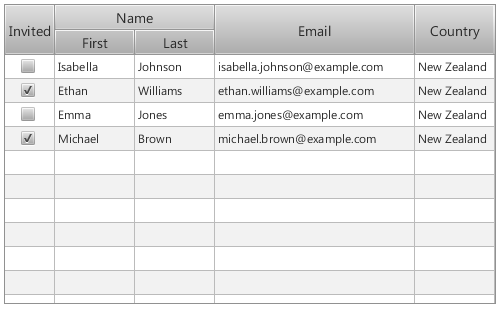
by Jonathan Giles | Nov 27, 2011 | Controls, Tips n' Tricks, UI Design
One thing I see asked a lot (either directly via email, or in the rather excellent JavaFX Forums) is why does TableView (and ListView) look like this in JavaFX 2.0:

A TableView control using default styling and API as provided in JavaFX 2.0.
(more…)








